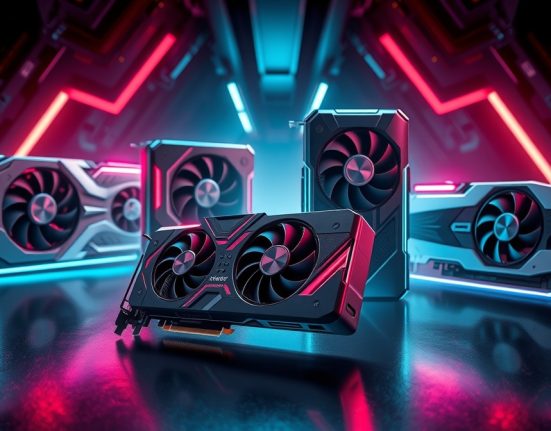In the evolving technological world of 2025, graphics cards have become critical components far beyond computer games. With advancements in artificial intelligence, video editing, augmented reality, and other digital fields, choosing the right graphics card is a significant decision that affects our ability to use computers for professional, creative, and personal needs. This guide aims to provide you with all the information needed to choose a graphics card that suits your needs in 2025, with special reference to uses that aren’t just related to gaming.
Changes in the Graphics Card Market in 2025
The graphics card market has undergone a significant revolution in recent years. Unlike in the past, where the main considerations focused primarily on gaming performance, today’s needs are much more diverse. Advancements in AI technologies and creative tools have created new demands for modern graphics cards. Manufacturers like NVIDIA, AMD, and even Intel with its renewed entry into the market, have responded to these changes with accelerated development of new architectures designed to optimize AI processes, scientific computation acceleration, and advanced media processing.
In 2025, we’re witnessing cards equipped with dedicated AI processing units (like new generation tensor cores in NVIDIA and AMD’s advanced AI Engines), VRAM in unprecedented volumes (with premium models offering up to 48GB and mid-range cards with 16-24GB as standard), and revolutionary cooling technologies that allow high performance over time without excessive noise. These improvements are designed to support a wide range of applications, from local processing of large language models, through real-time 3D rendering, to 8K video editing.
Key Considerations in Choosing a Graphics Card in 2025
When approaching the selection of a graphics card in the 2025 environment, we need to consider several key parameters that will help us make the right decision. The first and most critical parameter is personal need – exactly what you plan to do with your computer. For users focusing on creative work such as video editing, graphic design, or 3D modeling, it’s particularly important to focus on cards with generous VRAM and special cores for accelerating rendering processes. For users working with AI applications, technologies such as NVIDIA’s CUDA or AMD’s ROCm are of paramount importance, while paying attention that the software versions and models you plan to run support the specific platform of the card you’re considering.
Power consumption and energy efficiency have become more critical considerations than ever, with modern high-end cards that can easily consume over 450W under high loads. The budgetary consideration remains relevant, of course, but it should be taken into account that a quality card is a long-term investment – especially when it comes to a work tool that may affect your professional productivity. Finally, don’t neglect system compatibility – a sufficient power supply, a case with good ventilation, and a motherboard with an appropriate PCIe connection are all necessary to get the most out of your new card.
Graphics Cards for Local Artificial Intelligence Processing
One area that has developed dramatically in recent years is the ability to run advanced AI models locally on personal computers. In 2025, many users are interested in running large language models (LLMs), AI image generation tools, or even voice processing and object recognition systems – all without relying on cloud services and without privacy concerns.
For these uses, focus on two main components: special AI processing capabilities (such as tensor cores or ray tracing accelerators that can also be used for AI calculations) and the amount of graphic memory. For running medium-sized models efficiently, 16GB VRAM has become the recommended minimum threshold, while for larger models or professional tasks, cards with 24GB and above are recommended. NVIDIA’s RTX 5000 series presents significant improvements in AI performance compared to the previous generation, with even mid-range cards like the RTX 5070 offering performance that was previously reserved only for the most professional cards.
It’s important to note that software support is a decisive factor in this field. NVIDIA still holds a significant advantage thanks to its established CUDA ecosystem, but AMD is making great efforts to narrow the gap with its developing ROCm platform, which is gaining increasing support from software developers in the AI field. Intel, with its ARC series, offers an interesting option for those looking for an economical solution, although it still lags behind in overall support for the most popular models.
Graphics Cards for Creative and Professional Work
Another field that greatly benefits from powerful graphics cards is creative and professional work. For professionals in graphic design, video editing, digital architecture, and animation production, a powerful graphics card isn’t a luxury – it’s an essential work tool that directly affects efficiency and the ability to handle complex projects.
In the field of video editing, the new standards of 6K and 8K resolutions, and the development of advanced encoding formats such as AV1, pose particularly high demands. Cards such as AMD’s Radeon Pro series or NVIDIA’s RTX A series offer dedicated hardware accelerators for video encoding and decoding with impressive efficiency. For 3D rendering, new technologies such as real-time path tracing allow professionals to see realistic results at near-final quality already at the work stage, significantly shortening development times and design decisions.
It’s important to emphasize that for professional uses, reliability is as critical as performance. Cards from professional series typically undergo more rigorous testing processes and come with special drivers that have been optimized for professional software. Additionally, manufacturers often offer extended warranties for their professional product lines, providing additional peace of mind for those who rely on the equipment for their livelihood.
Graphics Cards for Home Multimedia Uses
Even for users who aren’t avid gamers or media professionals, a quality graphics card can significantly improve the computer user experience in 2025. Viewing high-quality content (such as 4K HDR streaming), editing family photos, or even high-quality video calls – all of these can become an enhanced experience with a suitable graphics card.
New technologies for AI-assisted image quality enhancement, such as NVIDIA’s DLSS and AMD’s FSR, aren’t just for games – they can also improve viewing of low-quality video by upscaling it to a higher resolution, or significantly improve the quality of video calls in challenging lighting conditions. New cards come with built-in support for advanced video and audio formats, including Dolby Vision, HDR10+, and AV1, ensuring an optimal viewing experience.
For home users who don’t need the top performance of flagship cards, there are excellent options in the mid and low price ranges that still provide all the capabilities needed for advanced multimedia uses. For example, NVIDIA’s RTX 5060 or AMD’s RX 8600 offer impressive performance alongside power savings and quiet operation, making them ideal for living room systems and home computers.
Technical Aspects Worth Knowing
Choosing a graphics card isn’t just about the number of cores and memory – there are additional technical aspects worth knowing to make an informed decision. One of the most important factors is the type and version of PCIe (PCI Express) connection. Most advanced graphics cards of 2025 support PCIe 5.0, which offers double the bandwidth of the previous generation. Although not all applications will utilize this full bandwidth, for tasks such as massive data transfer or working with raw video files, the improvement can be significant.
Another important topic is the card’s cooling system. With the increase in power consumption and generated heat, advanced cooling solutions have become essential. Manufacturers invest significant resources in developing efficient and quiet cooling solutions, including combinations of heat pipes, advanced thermal pads, and even built-in liquid cooling solutions in premium models. A card with a good cooling system will not only operate at lower temperatures but also display more stable performance over time and improved durability.
Power supply is another critical aspect, especially in performance cards. While the new 12V-2×6 connection standard (also known as 12VHPWR) has become common, ensure that your power supply supports this standard or equip yourself with an appropriate adapter. It’s important to remember that the total power consumption of your system must be taken into account, not just that of the graphics card.
Innovation and Future Technologies in Graphics Cards
In 2025, we’re witnessing several fascinating development directions in the graphics card industry. Among the most prominent innovations are new cards specifically designed for running generative AI locally. These cards come with dedicated architectures that allow efficient execution of complex models while using relatively low power – a trend that has become critical with the constant rise in electricity bills and environmental awareness.
New technologies such as hybrid parallel processing, combining different types of processing cores on the same card, allow high performance in different types of work with improved energy efficiency. The new HBM4 memory offers staggering speeds of up to 8TB/s, more than twice the previous generation, and opens new possibilities for a variety of applications that rely on fast data transfer.
It’s also evident that manufacturers are beginning to invest more in developing capabilities and tools for extended reality (XR) fields, including augmented reality and virtual reality. The new graphics cards offer special optimization for running XR applications with particularly low latency and advanced rendering capabilities tailored to the unique requirements of modern XR devices.
Summary and Future Outlook
Choosing a graphics card in 2025 is a more complex decision than ever before, but also one that offers more options for every type of user. The market offers a rich variety of solutions, from economical but efficient cards for home users, through versatile mid-range cards, to high-end solutions for professionals and those who need peak performance.
The key to the right choice lies in a precise understanding of your personal needs, both in the present and in the foreseeable future. It’s worth taking into account not only the raw performance but also parameters such as power consumption, noise level, long-term reliability, and the quality of support from the manufacturer. Carefully examine the software you use regularly and ensure that the card you’re considering purchasing offers support and optimization for them. In conclusion, the graphics card market of 2025 reflects the development and growing diversification in modern computer uses. With new technologies and constant improvements, the graphics card has transformed from a component primarily intended for games to a powerful tool that changes the way we work, create, and communicate in the digital space. A wise choice will ensure that you receive the best value for your investment, one that can serve you well in the coming years.














